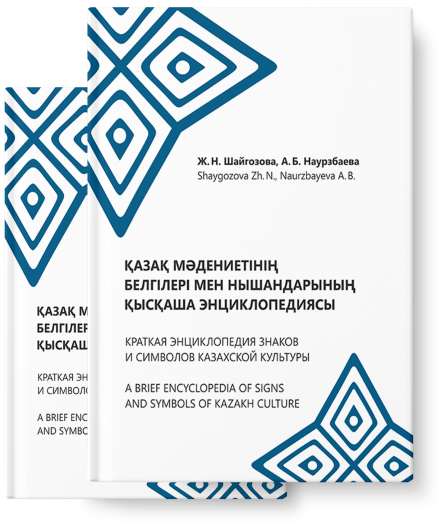
A short encyclopedia of
Signs and symbols of
Kazakh culture

Shanyraq – served as a family heirloom passed down the male line from generation to generation, it symbolized the continuity of the family. The younger or only son is called “shanyraq iesi” (the owner of the shanyraq). When constructing the yurt, the shanyraq was lifted only by the man, the owner, the father of the family, all other work was done by the women. When the last man of the family died, the shanyraq was placed on his grave, which meant that the family no longer existed.
K. Egizbayeva [3] believes that the special sacralization of the shanyraq is due to its connection with two important Turkic cults – tengri and ancestors. The father house of the Kazakhs is called “Qara shanyraq” (meaning: old, older, main house).
The etymology of the word “shanyraq” is not interpreted uniformly. There is a version according to which the first syllable “shan” comes from Indo-Iranian – “san” – “son”, which means the sun. This is connected with the design of the shanyrak – the cross in a circle – the oldest visual sign for the sun.
Shanyraq is an active participant in rites and rituals. It has a special significance in the birth ritual: in the frequent cases of infant death, the afterbirth of the baby was wrapped in a white koshma with seven black stones and hung on the shanyraku, and in case of safe delivery, the cervical vertebra of the ram (sacrificial animal) was hung on a staff. It was believed that during childbirth demonic creatures – albasty and qaraqus – sat on the shanyraky waiting for an opportunity to take the child’s soul. Perhaps such ideas served as the basis for decorating the dome circle with colorful woolen strings with tassels – ayaqbau. Shanyraq was considered a weak point (and also a threshold), as it directly bordered the outside world, was a kind of border between “alien” and “own”.
Analyzing the birth rites and mythological representations of the Kazakhs, N.Zh. Shahanova [9] notes that the shanyraq is connected with the female womb and gives birth to the beginning. And to protect the woman in labor from evil spirits, it was customary to hold a golden eagle at the shanyraq, which is a sacred bird in the understanding of the Kazakhs.
The union of the two principles (male and female) in the shanyraq once again underlines the complex of traditional symbolism. To this day, sayings connected with the shanyraq are widespread among the people: About the newlyweds they say, among others, “Shanyraq köterdi” (a new family has arisen); “Shanyrağtaryn biik bolsyn” (Let your Shanyraq be high!).

